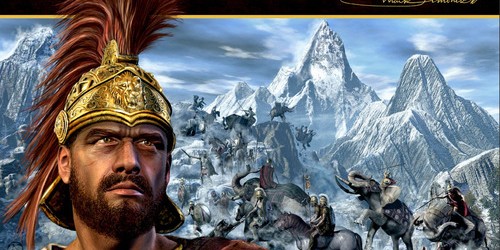By Fred Manzo
How to Use Varro and Longus in Hannibal: Rome vs Carthage
“If you know the enemy and know yourself, you need not fear the results of a hundred battles. If you know yourself but not the enemy, for every victory gained you will suffer a defeat. If you know neither the enemy nor yourself, you will succumb in every battle.”
Overview
 How bad were the Roman generals C. Terentius Varro and T. Sempronius Longus? In truth, very bad indeed. But just how bad was that? Well, traditionally Varro is held responsible for the Roman mega-disaster at Cannae during the Second Punic War (in 216 BC), and Longus was the chump Hannibal provoked into attacking him at the Battle of Trebbia (in 218 BC). Although both defeats are solidly in the ranks of world-class thumpings, because over 2 full legions fought their way out of the trap at Trebbia it is commonly considered the less bad trouncing. At Cannae, for example, Rome and its allies lost over 50,000 troops out of the 80 thousand they had there, while at Trebbia the Republic lost somewhere between 25,000 to 30,000 troops out of 40,000 +.So, in game terms Hannibal: Rome vs. Carthage (HRC) rates Varro as a “1 – 1″ general and Longus as a “2 -1″ general when on the defensive and as a “2 – 2″ general when on the offensive. (For purposes of comparison Hannibal is rated “1 – 4″). The first number is a general’s strategy rating and shows how easily he moves his army (with lower numbers being better), while the second number is a general’s tactical or battle rating and shows how well he does in combat (with higher numbers being better).
How bad were the Roman generals C. Terentius Varro and T. Sempronius Longus? In truth, very bad indeed. But just how bad was that? Well, traditionally Varro is held responsible for the Roman mega-disaster at Cannae during the Second Punic War (in 216 BC), and Longus was the chump Hannibal provoked into attacking him at the Battle of Trebbia (in 218 BC). Although both defeats are solidly in the ranks of world-class thumpings, because over 2 full legions fought their way out of the trap at Trebbia it is commonly considered the less bad trouncing. At Cannae, for example, Rome and its allies lost over 50,000 troops out of the 80 thousand they had there, while at Trebbia the Republic lost somewhere between 25,000 to 30,000 troops out of 40,000 +.So, in game terms Hannibal: Rome vs. Carthage (HRC) rates Varro as a “1 – 1″ general and Longus as a “2 -1″ general when on the defensive and as a “2 – 2″ general when on the offensive. (For purposes of comparison Hannibal is rated “1 – 4″). The first number is a general’s strategy rating and shows how easily he moves his army (with lower numbers being better), while the second number is a general’s tactical or battle rating and shows how well he does in combat (with higher numbers being better).
In any event, if the Roman player isn’t careful Varro and Longus will end up costing him entire armies whenever they appear. In fact, these generals are so bad Carthaginian players have been known to go out of their way to bring them to battle no matter where they are located, as all Carthaginian players need do is hold the initiative, watch the Roman player fail to re-gain it 3 or 4 times in a row and when the Carthaginians think they are on the ropes, finish them off with a Double Envelopment. And Presto Chango!, another army of the Roman Republic is all but eliminated. In fact, this outcome appears with such regularity that there are Roman players who consider declaring defeat immediately when forced to defend with either Varro or Longus. In such players’ eyes, it is better to lose quickly, than to lose big. After all, a first round defeat will probably not involve Double Envelopment cards or attritional losses and any retreat losses the defeated Romans suffer will be the same whether the battle is a short one or a long one. The only downside to this idea is that while it minimizes Roman losses it completely eliminates Carthaginian losses. And because Rome raises troops more easily than Hannibal and his friends, attritional losses, which affect both players equally, favor the Old Republic. Simply put, attritional losses are friends of the Senate and People of Rome.
So, although we are dealing with terrible generals, we are not dealing with useless ones. And, in fact, their proper handling, when they do appear in Hannibal: Rome vs. Carthage is one of the secrets of playing a superior Roman game.
So let’s take a closer look…
C. Terentius Varro
Cons:
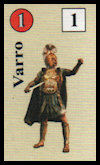 As defeating Varro is hardly a “man bites dog” story, Roman players should never let him anywhere near Hannibal, or for that matter any full strength Carthaginian army. But, if he is forced into such a battle, they might consider declaring defeat either immediately or whenever he is sure the defeat will not involve a Double Envelopment. Although, of course, it is infinitely better that things never get to this point. An exception to this rule is when Rome launches a major or minor campaign against Hannibal, which usually happens when the Carthaginians have their back against a mountain range or are deep in enemy territory. (That is, when any forced retreat will eliminate the defeated army.)So if multiple armies fighting Hannibal have already reduced his strength to say 3 Combat Units (CUs) through some combination of attritional and retreat losses, even Varro should attack when leading a full-strength army. In such a case, Rome will have 13 cards if the battle takes place in Italy and Hannibal will have say, 8. Based on the excellent estimates published by Brandon Einhorn on Grognard.com, under these circumstances Varro would have over a 70 percent chance of winning. But even if Varro loses, the battle ought to last long enough for the Carthaginians to suffer additional attritional losses. So Hannibal will, in all likelihood, not launch a subsequent attack even if he does triumph, but instead use the time give him to get out of Dodge. Accordingly, in these cases, the chance of eliminating Hannibal far outweighs the chance of Varro losing again.
As defeating Varro is hardly a “man bites dog” story, Roman players should never let him anywhere near Hannibal, or for that matter any full strength Carthaginian army. But, if he is forced into such a battle, they might consider declaring defeat either immediately or whenever he is sure the defeat will not involve a Double Envelopment. Although, of course, it is infinitely better that things never get to this point. An exception to this rule is when Rome launches a major or minor campaign against Hannibal, which usually happens when the Carthaginians have their back against a mountain range or are deep in enemy territory. (That is, when any forced retreat will eliminate the defeated army.)So if multiple armies fighting Hannibal have already reduced his strength to say 3 Combat Units (CUs) through some combination of attritional and retreat losses, even Varro should attack when leading a full-strength army. In such a case, Rome will have 13 cards if the battle takes place in Italy and Hannibal will have say, 8. Based on the excellent estimates published by Brandon Einhorn on Grognard.com, under these circumstances Varro would have over a 70 percent chance of winning. But even if Varro loses, the battle ought to last long enough for the Carthaginians to suffer additional attritional losses. So Hannibal will, in all likelihood, not launch a subsequent attack even if he does triumph, but instead use the time give him to get out of Dodge. Accordingly, in these cases, the chance of eliminating Hannibal far outweighs the chance of Varro losing again.
Pros:
Varro moves troops easily as his strategy rating is a one. On the Roman side, he is only matched by the great Scipio Africanus himself, who enters the game on turn 6, and Gaius Nero. This ease of movement allows Varro to act as a “political” general converting pro-Carthage towns and tribes into Roman ones.
Varro readily conducts sieges. This is also due to his strategy rating. Now, while it is true his lowly battle rating makes it unlikely he can lead large armies successfully, a 5 Combat Unit army subjugating, say, Bruttium, the tribal area in southern Italy, is a target more fitting his limited abilities.He should consider targeting this particular tribe because once it is subdued, Carthage’s options in southern Italy become restricted. For without Bruttium as an ally, Carthaginian political incursions there will, in all probability, draw their supply solely from Croton (as Croton is the only unfortified port in southern Italy) and, so, become open to destruction by a Diplomacy card or even a small army. Of course, Carthage could dispatch forces to prevent their enclave from being eliminated, but the drain of keeping them so deep in Roman territory usually leads to a bigger disaster. And as Varro can be activated by any card, it is unlikely the Roman player would have given up much to create this situation anyway.Of course, having a 5 CU force means Varro is unable to drop off units on the march seeing that he is already at the minimum size for a Consular army but, then, he doesn’t really need to in order to fulfill his objectives.
As a Consul, Varro is well suited for anti-raider duties, because he should win any battle where his opponent has 6 or fewer cards AND he is attacking. This is due to there being 6 card suits in HRC: Probe (with 8 cards), Double Envelopment (with 6 cards), Reserve (4 cards), Left Flank (9), Frontal Assault (12) and Right Flank (9). So it’s likely a defender with so few cards will find them spread something along the lines of 1 Right and Left Flank card, a Double Envelopment card, a Probe card, probably 1 or 2 Frontal Assaults cards and just occasionally a Reserve card, which is a mighty thin defense. Given that Varro could win the battle with the play of a single card, although it’s more likely he’d need 2, it is possible the defender could be defeated before he had a chance to try for the initiative. Plus, even if combat goes beyond the first round, the odds of the Carthaginians winning the initiative with the likes of Gisgo or Mago in command are slight. And, who else is there? Hannibal and Hasdrubal are much too valuable to risk in small scale battles and Hanno can’t leave Africa. Simply put, when Varro wins a battle quickly enough it doesn’t really matter how bad he is in re-gaining the initiative.
Bottom Line:
Optimally, Varro should lead a 5 CU Consular army in Italy or Sicily. Any army smaller than that would require him to be a Proconsul and as it’s highly unlikely any Roman player would voluntarily keep him a second longer than is necessary, it’s also unlikely he would ever be selected for such a position. (Although Carthage could play the “Senate Dismisses Proconsul card” and pick Varro as the replacement, Longus is just as bad on the defense and he’s harder to move.)
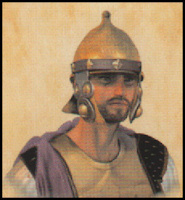 Of course, using Varro to lead any army larger than 5 CUs, while sometimes unavoidable, is not a good idea. First, why make him any more tempting a target then he already is, and second, having more than 5 CUs is not necessary for his primary duties of besieging and subjugating, hunting down raiders and eliminating Carthaginian political control (PC) markers. And finally, limiting him to 5 CUs means Rome is risking the absolute minimum as even if Varro loses his army, the Roman Republic is out, at most, 5 Combat Units and 2 political control markers.
Of course, using Varro to lead any army larger than 5 CUs, while sometimes unavoidable, is not a good idea. First, why make him any more tempting a target then he already is, and second, having more than 5 CUs is not necessary for his primary duties of besieging and subjugating, hunting down raiders and eliminating Carthaginian political control (PC) markers. And finally, limiting him to 5 CUs means Rome is risking the absolute minimum as even if Varro loses his army, the Roman Republic is out, at most, 5 Combat Units and 2 political control markers.
Although it is possible for Varro to win occasionally simply by running his opponent out of all his battle cards, this scheme requires either a lot of luck or a lot of cards to work.
Therefore, a good rule of thumb for Varro is that he can attack if he has a 4 battle card advantage (a 5 card advantage versus Hannibal) or his opponent has 6 or fewer battle cards.
T. Sempronius Longus
Cons:
Regrettably, Longus has a strategy rating of 2, so he’s the more difficult of the two to move. Being as bad defensively as Varro but harder to move are not the sort of traits one would brag about to the Senate.
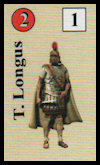 Longus also has a tactical rating of one when on the defensive. Now, it’s important for players to realize just how bad this rating is, it being much, much worse than even a lowly rating of 2. This is due to the number of attempts it will take such a general to gain or re-gain the initiative. After all, rolling a 1 on a 6 sided die should take on average 6 attempts. But, because the attacking Carthaginians start with the initiative, and don’t have to roll for it to begin combat, there might be as many as 7 rounds of combat before Varro or Longus could be expected to wrench the initiative from their tormentors.On the other hand, a general with a 2 battle rating would need, on average, only 3 attempts to win back the initiative. Longus (when on the defense) and Varro’s basic problem is, therefore, that most battles end long before they can be expected to gain control of the situation. Unfortunately, when you give your opponent 7 chances to find a hole in your lines before you try to find a hole in his, you usually are toast. Of course, strange things do happen in combat, but regrettably they can’t be depended upon when Varro or Longus are involved.By the way, this uncertainty is one of the great strengths of a well designed battle card system. For, as in real life, players cannot guarantee themselves minimum or maximum outcomes by reading a column on a Combat Results Table (CRT).
Longus also has a tactical rating of one when on the defensive. Now, it’s important for players to realize just how bad this rating is, it being much, much worse than even a lowly rating of 2. This is due to the number of attempts it will take such a general to gain or re-gain the initiative. After all, rolling a 1 on a 6 sided die should take on average 6 attempts. But, because the attacking Carthaginians start with the initiative, and don’t have to roll for it to begin combat, there might be as many as 7 rounds of combat before Varro or Longus could be expected to wrench the initiative from their tormentors.On the other hand, a general with a 2 battle rating would need, on average, only 3 attempts to win back the initiative. Longus (when on the defense) and Varro’s basic problem is, therefore, that most battles end long before they can be expected to gain control of the situation. Unfortunately, when you give your opponent 7 chances to find a hole in your lines before you try to find a hole in his, you usually are toast. Of course, strange things do happen in combat, but regrettably they can’t be depended upon when Varro or Longus are involved.By the way, this uncertainty is one of the great strengths of a well designed battle card system. For, as in real life, players cannot guarantee themselves minimum or maximum outcomes by reading a column on a Combat Results Table (CRT).
Longus should never be in the position of facing Hannibal unless he is leading the second or third army needed for a knock-out blow. After all, he’s unlikely to eliminate Hannibal and if the Carthaginians go over to the offensive, Longus is history.
Pros:
As Longus has a two tactical rating when attacking (for counter-attack purposes not for card counting purposes), it ought to take him on average only 3 attempts to re-capture the initiative even if it is lost. This makes him an adequate general for offensive operations (only).
Bottom Line:
Longus’ primary duties should be leading 5 or fewer CUs against Carthaginian raiders and converting Carthaginian political control markers when generals more easily moved are not available. As the Roman player starts with Longus activated it’s entirely possible he will be the Proconsul for a number of turns in a typical game. So an army of 3 to 5 CUs under his command is possible. Although a 3 CU army is a bit light. Such a force allows him to start a siege but it doesn’t really allow him to finish one as he may take a loss prosecuting it and so drop below the minimum needed to continue. And as a 2 Ops point card is required to activate him, it’s that much more expensive to undertake these operations in the first place. So besieging with Longus is not recommended, although it is possible. And unless he eliminates his opponent, Rome also has to worry about the defeated enemy (weakened but not eradicate) returning the favor. Therefore, anti-raider duty, where defeated opponents are unlikely to survive is the best use of this general. Although having him attack whenever he is favored to destroy his opponent is also acceptable.
Final Word
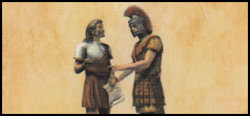 So if Rome finds itself in the unenviable position of having to depend on Varro or Longus the situation while not the best, is certainly not lost. It’s only when both have been elected simultaneously and then only during the critical first 5 turns of a game when Rome is limited to three generals, that it will find itself in deep, deep trouble.
So if Rome finds itself in the unenviable position of having to depend on Varro or Longus the situation while not the best, is certainly not lost. It’s only when both have been elected simultaneously and then only during the critical first 5 turns of a game when Rome is limited to three generals, that it will find itself in deep, deep trouble.
Related:
Roman Generals in the Board Game Hannibal: Rome vs Carthage
Seizing the Tactical Initiative in the Hannibal: Rome vs Carthage Board Game
Seizing the Strategic Initiative in Hannibal: Rome vs Carthage


